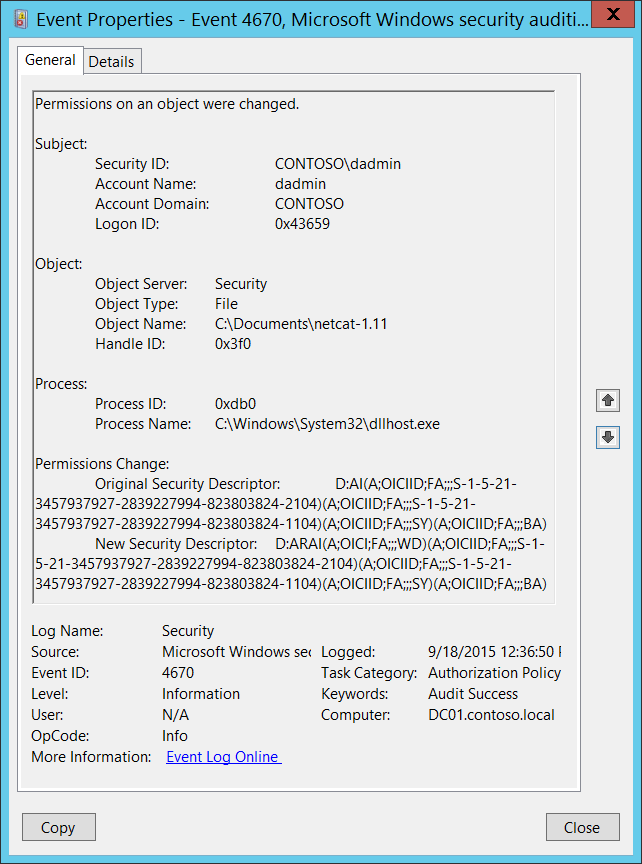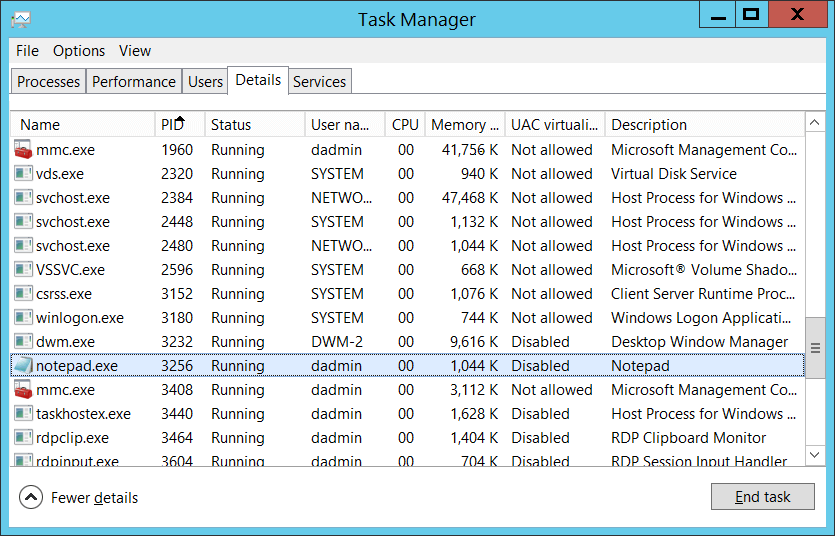4670(S): Permissions on an object were changed.

Subcategories: Audit File System, Audit Registry, Audit Authentication Policy Change, and Audit Authorization Policy Change
Event Description:
This event generates when the permissions for an object are changed. The object could be a file system, registry, or security token object.
This event does not generate if the SACL (Auditing ACL) was changed.
Before this event can generate, certain ACEs might need to be set in the object’s SACL. For example, for a file system object, it generates only if “Change Permissions" and/or "Take Ownership” are set in the object’s SACL. For a registry key, it generates only if “Write DAC" and/or "Write Owner” are set in the object’s SACL.
Note For recommendations, see Security Monitoring Recommendations for this event.
Event XML:
- <Event xmlns="http://schemas.microsoft.com/win/2004/08/events/event">
- <System>
<Provider Name="Microsoft-Windows-Security-Auditing" Guid="{54849625-5478-4994-A5BA-3E3B0328C30D}" />
<EventID>4670</EventID>
<Version>0</Version>
<Level>0</Level>
<Task>13570</Task>
<Opcode>0</Opcode>
<Keywords>0x8020000000000000</Keywords>
<TimeCreated SystemTime="2015-09-18T19:36:50.187044600Z" />
<EventRecordID>269529</EventRecordID>
<Correlation />
<Execution ProcessID="516" ThreadID="524" />
<Channel>Security</Channel>
<Computer>DC01.contoso.local</Computer>
<Security />
</System>
- <EventData>
<Data Name="SubjectUserSid">S-1-5-21-3457937927-2839227994-823803824-1104</Data>
<Data Name="SubjectUserName">dadmin</Data>
<Data Name="SubjectDomainName">CONTOSO</Data>
<Data Name="SubjectLogonId">0x43659</Data>
<Data Name="ObjectServer">Security</Data>
<Data Name="ObjectType">File</Data>
<Data Name="ObjectName">C:\\Documents\\netcat-1.11</Data>
<Data Name="HandleId">0x3f0</Data>
<Data Name="OldSd">D:AI(A;OICIID;FA;;;S-1-5-21-3457937927-2839227994-823803824-2104)(A;OICIID;FA;;;S-1-5-21-3457937927-2839227994-823803824-1104)(A;OICIID;FA;;;SY)(A;OICIID;FA;;;BA)</Data>
<Data Name="NewSd">D:ARAI(A;OICI;FA;;;WD)(A;OICIID;FA;;;S-1-5-21-3457937927-2839227994-823803824-2104)(A;OICIID;FA;;;S-1-5-21-3457937927-2839227994-823803824-1104)(A;OICIID;FA;;;SY)(A;OICIID;FA;;;BA)</Data>
<Data Name="ProcessId">0xdb0</Data>
<Data Name="ProcessName">C:\\Windows\\System32\\dllhost.exe</Data>
</EventData>
</Event>
Required Server Roles: None.
Minimum OS Version: Windows Server 2008, Windows Vista.
Event Versions: 0.
Field Descriptions:
Subject:
- Security ID [Type = SID]: SID of account that requested the “change object’s permissions” operation. Event Viewer automatically tries to resolve SIDs and show the account name. If the SID cannot be resolved, you will see the source data in the event.
Note A security identifier (SID) is a unique value of variable length used to identify a trustee (security principal). Each account has a unique SID that is issued by an authority, such as an Active Directory domain controller, and stored in a security database. Each time a user logs on, the system retrieves the SID for that user from the database and places it in the access token for that user. The system uses the SID in the access token to identify the user in all subsequent interactions with Windows security. When a SID has been used as the unique identifier for a user or group, it cannot ever be used again to identify another user or group. For more information about SIDs, see Security identifiers.
Account Name [Type = UnicodeString]: the name of the account that requested the “change object’s permissions” operation.
Account Domain [Type = UnicodeString]: subject’s domain or computer name. Formats vary, and include the following:
Domain NETBIOS name example: CONTOSO
Lowercase full domain name: contoso.local
Uppercase full domain name: CONTOSO.LOCAL
For some well-known security principals, such as LOCAL SERVICE or ANONYMOUS LOGON, the value of this field is “NT AUTHORITY”.
For local user accounts, this field will contain the name of the computer or device that this account belongs to, for example: “Win81”.
Logon ID [Type = HexInt64]: hexadecimal value that can help you correlate this event with recent events that might contain the same Logon ID, for example, “4624: An account was successfully logged on.”
Object:
Object Server [Type = UnicodeString]: has “Security” value for this event.
Object Type [Type = UnicodeString]: The type of an object that was accessed during the operation.
The following table contains the list of the most common Object Types:
| Directory | Event | Timer | Device |
|---|---|---|---|
| Mutant | Type | File | Token |
| Thread | Section | WindowStation | DebugObject |
| FilterCommunicationPort | EventPair | Driver | IoCompletion |
| Controller | SymbolicLink | WmiGuid | Process |
| Profile | Desktop | KeyedEvent | Adapter |
| Key | WaitablePort | Callback | Semaphore |
| Job | Port | FilterConnectionPort | ALPC Port |
Object Name [Type = UnicodeString]: name and other identifying information for the object for which permissions were changed. For example, for a file, the path would be included. For Token objects, this field typically equals “-“.
Handle ID [Type = Pointer]: hexadecimal value of a handle to Object Name. This field can help you correlate this event with other events that might contain the same Handle ID, for example, “4663(S): An attempt was made to access an object.” This parameter might not be captured in the event, and in that case appears as “0x0”.
Process:
Process ID [Type = Pointer]: hexadecimal Process ID of the process through which the permissions were changed. Process ID (PID) is a number used by the operating system to uniquely identify an active process. To see the PID for a specific process you can, for example, use Task Manager (Details tab, PID column):

If you convert the hexadecimal value to decimal, you can compare it to the values in Task Manager.
You can also correlate this process ID with a process ID in other events, for example, “4688: A new process has been created” Process Information\New Process ID.
Process Name [Type = UnicodeString]: full path and the name of the executable for the process.
Permissions Change:
Original Security Descriptor [Type = UnicodeString]: the old Security Descriptor Definition Language (SDDL) value for the object.
New Security Descriptor [Type = UnicodeString]: the new Security Descriptor Definition Language (SDDL) value for the object.
Note The Security Descriptor Definition Language (SDDL) defines string elements for enumerating information contained in the security descriptor.
Example:
O:BAG:SYD:(D;;0xf0007;;;AN)(D;;0xf0007;;;BG)(A;;0xf0007;;;SY)(A;;0×7;;;BA)S:ARAI(AU;SAFA;DCLCRPCRSDWDWO;;;WD)
- O: = Owner. SID of specific security principal, or reserved (pre-defined) value, for example: BA (BUILTIN_ADMINISTRATORS), WD (Everyone), SY (LOCAL_SYSTEM), etc. See the list of possible values in the table below:
| Value | Description | Value | Description |
|---|---|---|---|
| "AO" | Account operators | "PA" | Group Policy administrators |
| "RU" | Alias to allow previous Windows 2000 | "IU" | Interactively logged-on user |
| "AN" | Anonymous logon | "LA" | Local administrator |
| "AU" | Authenticated users | "LG" | Local guest |
| "BA" | Built-in administrators | "LS" | Local service account |
| "BG" | Built-in guests | "SY" | Local system |
| "BO" | Backup operators | "NU" | Network logon user |
| "BU" | Built-in users | "NO" | Network configuration operators |
| "CA" | Certificate server administrators | "NS" | Network service account |
| "CG" | Creator group | "PO" | Printer operators |
| "CO" | Creator owner | "PS" | Personal self |
| "DA" | Domain administrators | "PU" | Power users |
| "DC" | Domain computers | "RS" | RAS servers group |
| "DD" | Domain controllers | "RD" | Terminal server users |
| "DG" | Domain guests | "RE" | Replicator |
| "DU" | Domain users | "RC" | Restricted code |
| "EA" | Enterprise administrators | "SA" | Schema administrators |
| "ED" | Enterprise domain controllers | "SO" | Server operators |
| "WD" | Everyone | "SU" | Service logon user |
- G: = Primary Group.
- D: = DACL Entries.
- S: = SACL Entries.
DACL/SACL entry format: entry_type:inheritance_flags(ace_type;ace_flags;rights;object_guid;inherit_object_guid;account_sid)
Example: D:(A;;FA;;;WD)
- entry_type:
“D” - DACL
“S” - SACL
- inheritance_flags:
"P” - SDDL_PROTECTED, Inheritance from containers that are higher in the folder hierarchy are blocked.
"AI" - SDDL_AUTO_INHERITED, Inheritance is allowed, assuming that "P" Is not also set.
"AR" - SDDL_AUTO_INHERIT_REQ, Child objects inherit permissions from this object.
- ace_type:
"A" - ACCESS ALLOWED
"D" - ACCESS DENIED
"OA" - OBJECT ACCESS ALLOWED: only applies to a subset of the object(s).
"OD" - OBJECT ACCESS DENIED: only applies to a subset of the object(s).
"AU" - SYSTEM AUDIT
"A" - SYSTEM ALARM
"OU" - OBJECT SYSTEM AUDIT
"OL" - OBJECT SYSTEM ALARM
- ace_flags:
"CI" - CONTAINER INHERIT: Child objects that are containers, such as directories, inherit the ACE as an explicit ACE.
"OI" - OBJECT INHERIT: Child objects that are not containers inherit the ACE as an explicit ACE.
"NP" - NO PROPAGATE: only immediate children inherit this ace.
"IO" - INHERITANCE ONLY: ace doesn’t apply to this object, but may affect children via inheritance.
"ID" - ACE IS INHERITED
"SA" - SUCCESSFUL ACCESS AUDIT
"FA" - FAILED ACCESS AUDIT
- rights: A hexadecimal string which denotes the access mask or reserved value, for example: FA (File All Access), FX (File Execute), FW (File Write), etc.
| Value | Description | Value | Description |
|---|---|---|---|
| Generic access rights | Directory service access rights | ||
| "GA" | GENERIC ALL | "RC" | Read Permissions |
| "GR" | GENERIC READ | "SD" | Delete |
| "GW" | GENERIC WRITE | "WD" | Modify Permissions |
| "GX" | GENERIC EXECUTE | "WO" | Modify Owner |
| File access rights | "RP" | Read All Properties | |
| "FA" | FILE ALL ACCESS | "WP" | Write All Properties |
| "FR" | FILE GENERIC READ | "CC" | Create All Child Objects |
| "FW" | FILE GENERIC WRITE | "DC" | Delete All Child Objects |
| "FX" | FILE GENERIC EXECUTE | "LC" | List Contents |
| Registry key access rights | "SW" | Self Write | |
| "KA" | KEY ALL ACCESS | "LO" | List Object |
| "KR" | KEY READ | "DT" | Delete Subtree |
| "KW" | KEY WRITE | "CR" | All Extended Rights |
| "KX" | KEY EXECUTE |
- object_guid: N/A
- inherit_object_guid: N/A
- account_sid: SID of specific security principal, or reserved value, for example: AN (Anonymous), WD (Everyone), SY (LOCAL_SYSTEM), etc. See the table above for more details.
For more information about SDDL syntax, see these articles: https://msdn.microsoft.com/library/cc230374.aspx, https://msdn.microsoft.com/library/windows/hardware/aa374892(v=vs.85).aspx.
Security Monitoring Recommendations
For 4670(S): Permissions on an object were changed.
For token objects, this is typically an informational event, and at the same time it is difficult to identify which token's permission were changed. For token objects, there are no monitoring recommendations for this event in this document.
For file system and registry objects, the following recommendations apply.
Important For this event, also see Appendix A: Security monitoring recommendations for many audit events.
If you have a pre-defined “Process Name” for the process reported in this event, monitor all events with “Process Name” not equal to your defined value.
You can monitor to see if “Process Name” is not in a standard folder (for example, not in System32 or Program Files) or is in a restricted folder (for example, Temporary Internet Files).
If you have a pre-defined list of restricted substrings or words in process names (for example, “mimikatz” or “cain.exe”), check for these substrings in “Process Name.”
If you have critical registry objects for which you need to monitor all modifications (especially permissions changes and owner changes), monitor for the specific Object\Object Name.
If you have high-value computers for which you need to monitor all changes for all or specific objects (for example, file system or registry objects), monitor for all 4670 events on these computers. For example, you could monitor the ntds.dit file on domain controllers.